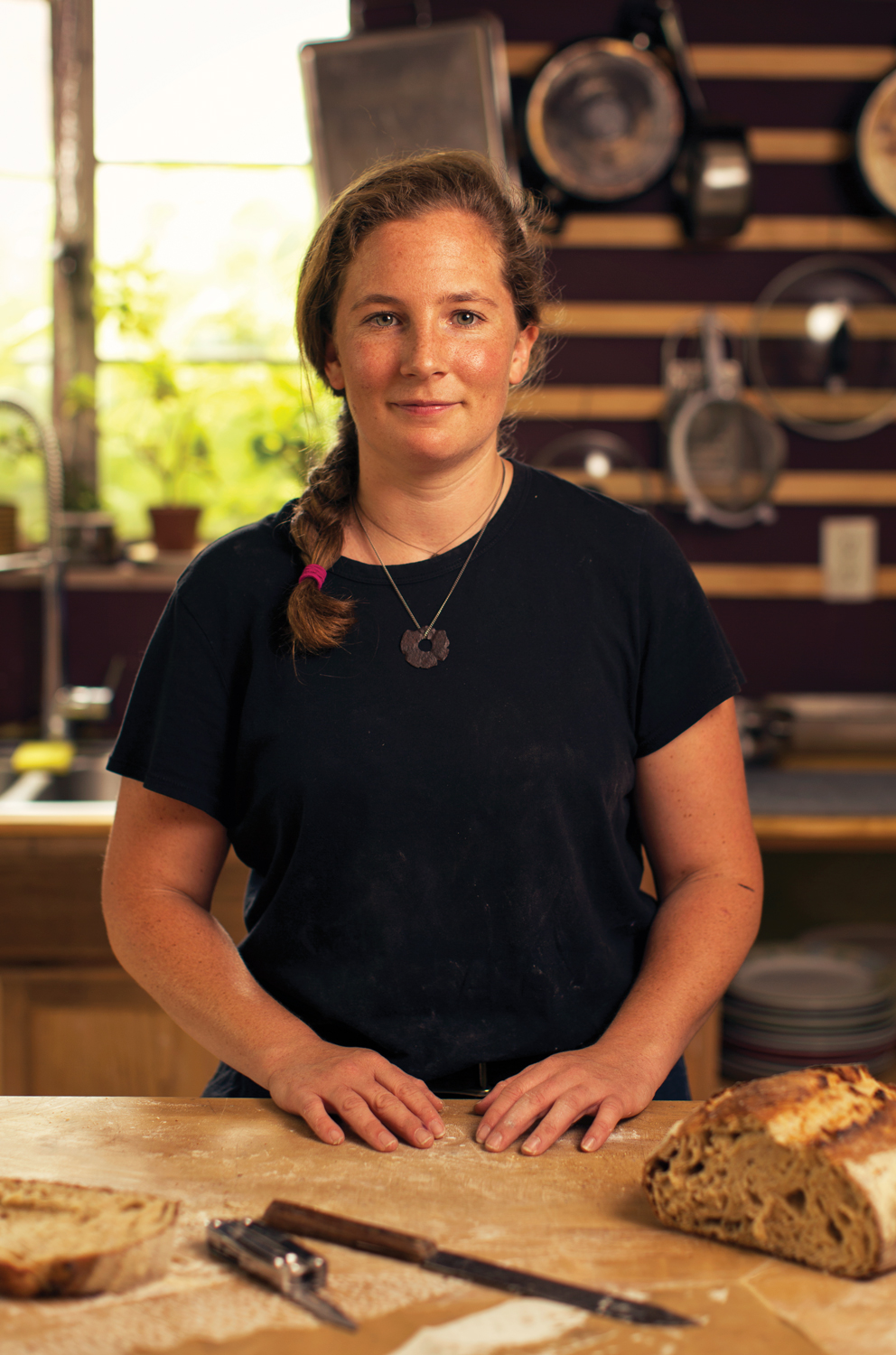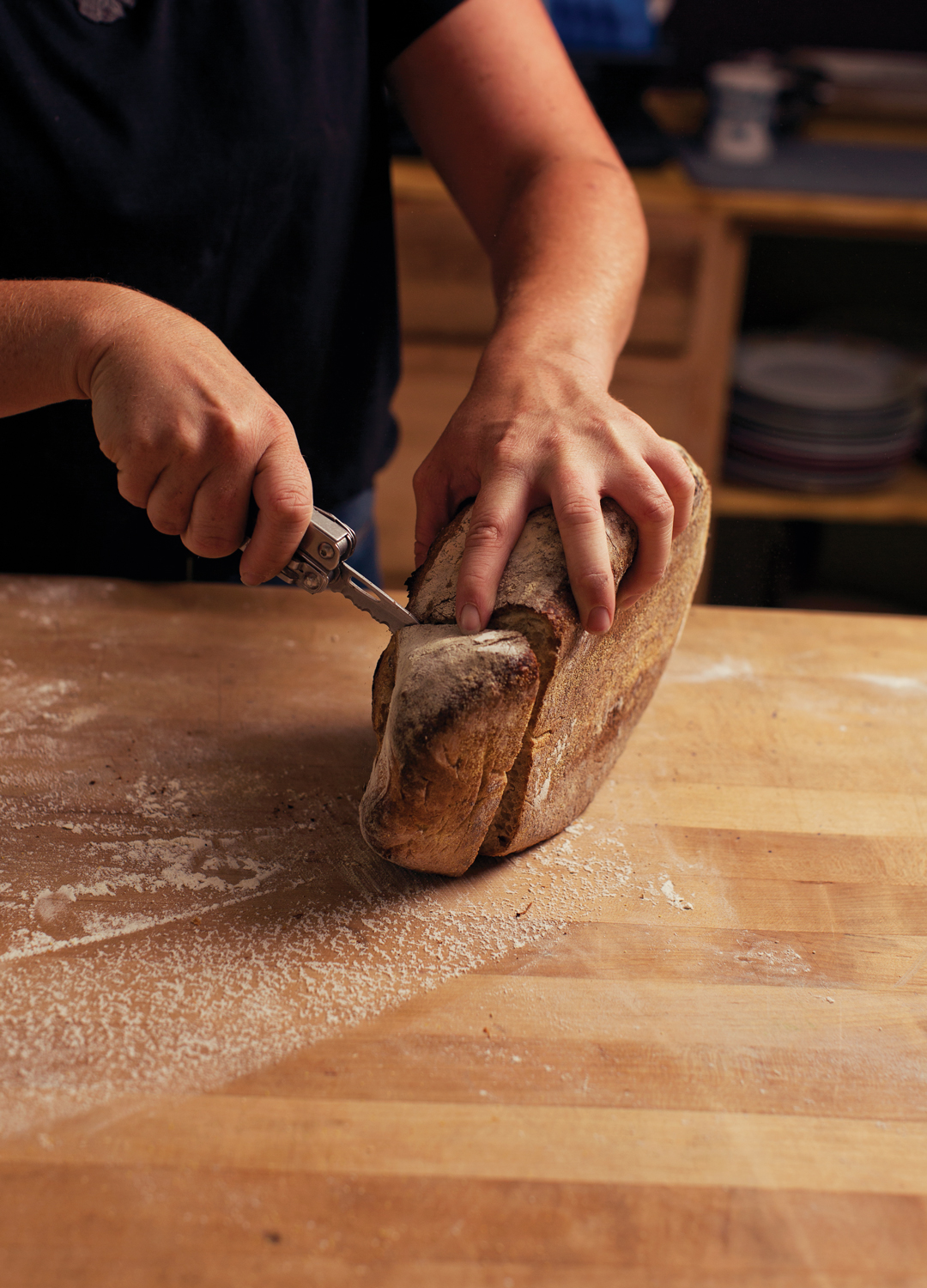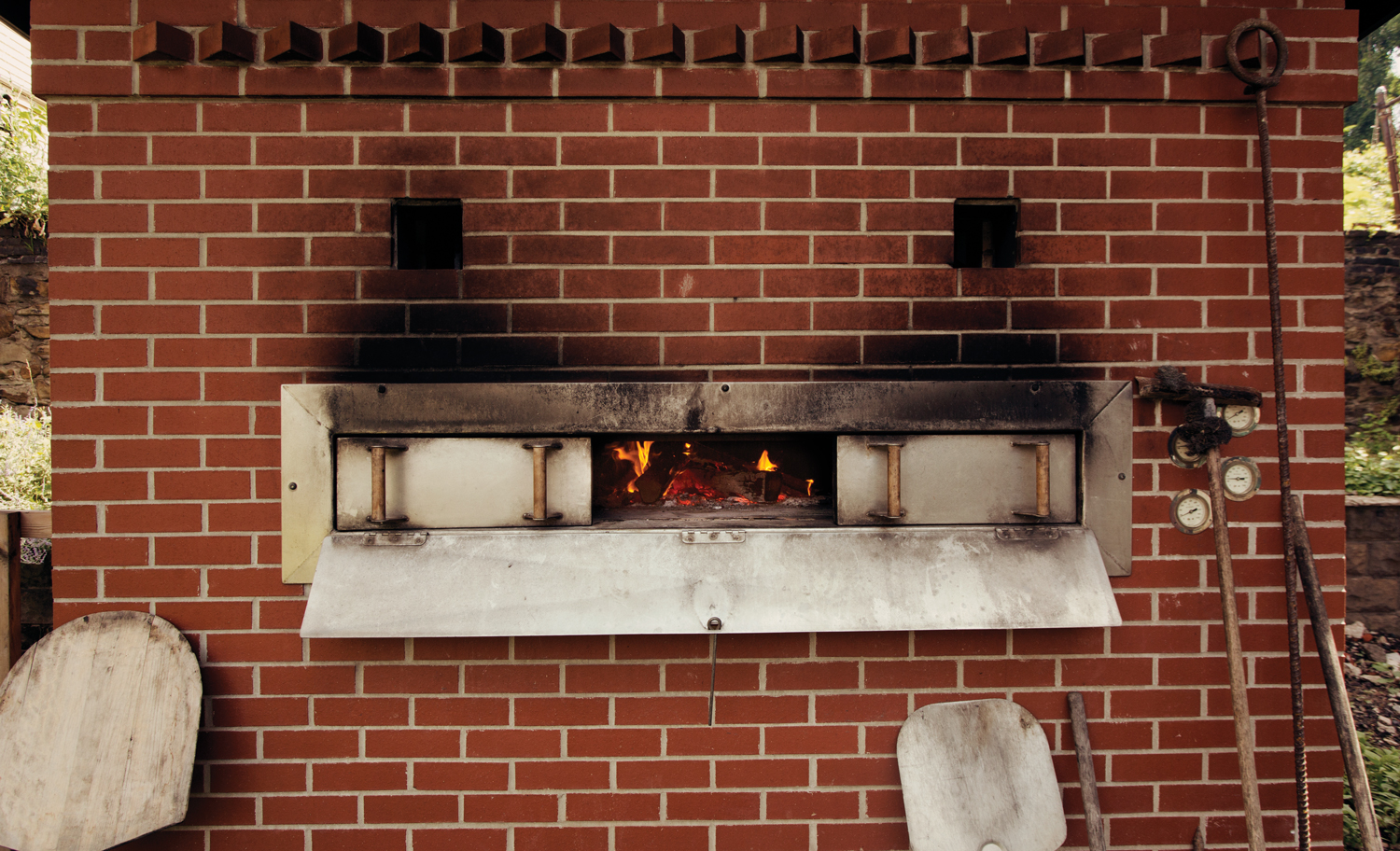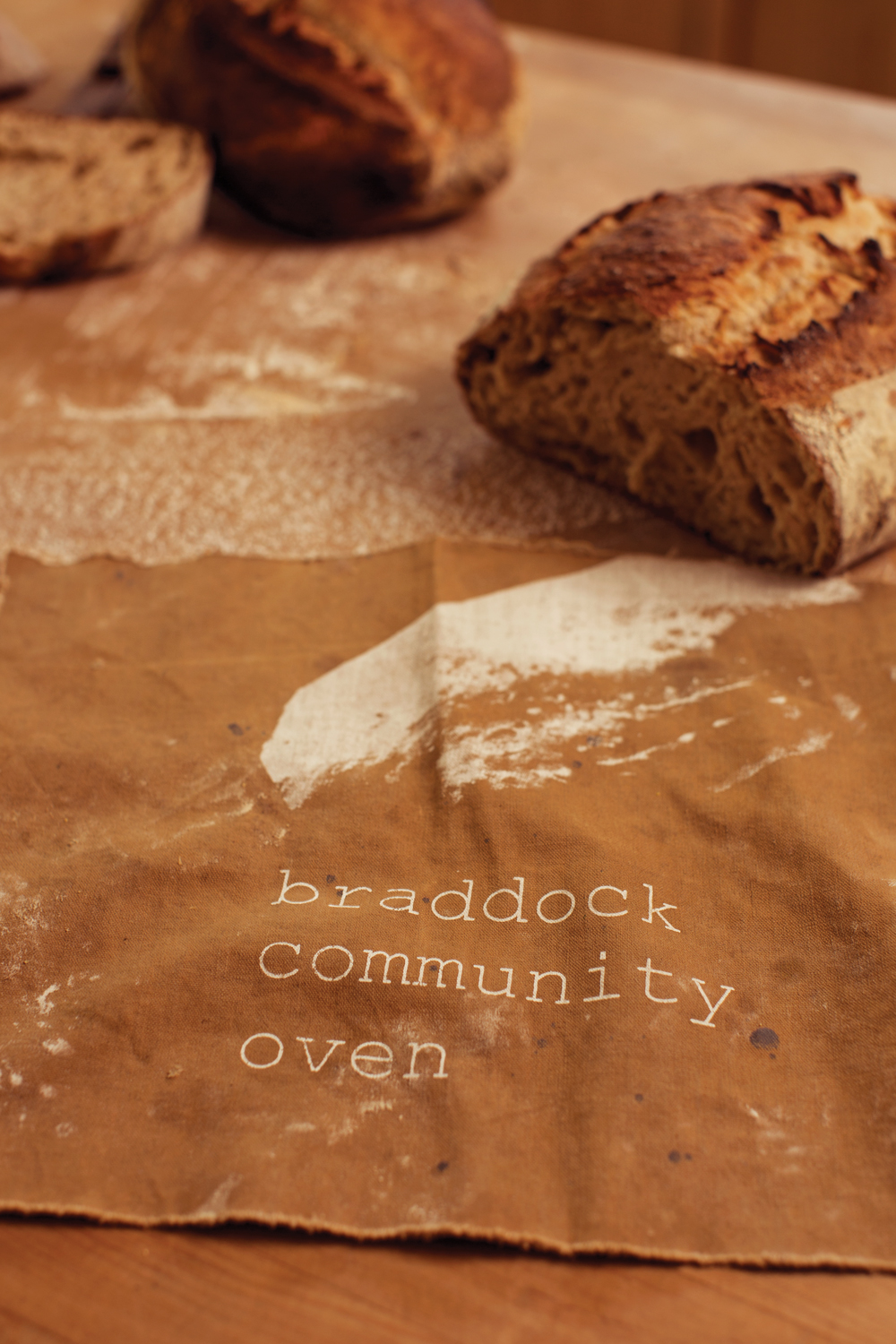Chatham University Grad Shauna Kearns Brings the Braddock Community Together, One Loaf of Bread at a Time
By Emma Honcharski | Art Direction by Jason Solak
On one side of Braddock Avenue, the faded blue warehouse of an old steel mill produces ambient noise and spits smoke into the air. But across the street, set back from the road, you’ll find smells of a campfire and fresh bread, and an oven giving a much more positive connotation to the smoky air in Braddock, where the only fuel you’ll find is pizza.
When the steel mills were the city’s livelihood, Braddock’s population peaked at about 20,000. Driving down the main drag meant experiencing a bustling downtown and thriving community. Since the collapse of the steel industry, the small town due southeast of Pittsburgh is now home to about 2,000 people, with most storefronts boarded up. But the community is present as ever, and as the area turns around with outside influence and consequent rising property value, Shauna Kearns is working to strengthen the connection between the Braddock community and their food.
Since Braddock is still a neighborhood without a grocery store, and a stressed relationship with food, keeping a bread oven as an accessible resource is one of her top priorities. “A really important part of baking for me is sort of tied into the spirit of apprenticeship and being willing to teach other people how to do the whole process,” she says. “That’s something that is sort of forgotten, except for with trades. I think that’s why it’s so incredible to work at the Braddock oven.” For Kearns, giving back is a necessary part of the work she does. “Right now, the focus is teaching other people, and it just feels like that’s a very natural part of baking.”
Shauna’s Story
Kearns moved to Pittsburgh in 2013 to look at community ovens through an academic lens with Chatham University’s food studies program. She moved from Toronto, where community ovens are much more commonplace. After receiving a business degree in Montreal that she wasn’t quite sure what she wanted to do with, she decided to take her baking more seriously. "That was the moment it became like, ‘Oh, I’m a home baker now,’ but I’ve had my hands on hundreds of loaves of bread,” Kearns says. She recognized the potential there was in a professional setting for baking and took herself up on the challenge.

After participating in a multi-month long apprenticeship at Tracebridge Sourdough Bakery in the UK, she moved back to Toronto and completed a three-month apprenticeship at St. John’s Bakery, then was hired as a baker. St. John’s is a nonprofit organization with a focus on baking apprenticeships and opportunities for individuals who may otherwise face difficulties with traditional employment. At the same time, she was volunteering at a community oven in the area, where she realized what an interesting site of food production community ovens are. “There’s someone who bakes for the farmers market, but then after 3 p.m., anyone can come and use the leftover heat to bake their own bread,” she says. "All these different types of people feel connected to these spaces in different ways.”
Kearns intended to focus on community ovens in Toronto, but quickly realized this didn’t feel close enough to home anymore. Her first trip to the oven in Braddock was for an event hosted by Rick Easton, owner of Bread and Salt, which closed in early 2016. The original oven in Braddock was built in 2008, through the work of Ray Werner, one of Pittsburgh’s community oven advocates, and John Fetterman, the mayor of Braddock. While she knew it was an important asset to the events it was used for at the time, she felt that it wasn’t living up to its potential or serving the Braddock community in the way many bread ovens she was familiar with in Toronto had.
But as soon as she began using the oven regularly, it started to deteriorate. “So then I started selling bread, sort of pay-what-you-can, to raise money to build a larger oven that would be capable of being a platform for more instruction and so more people could come use it.” Her motivation quickly paid off.
The current oven, which is more than two times the size of the original, was built in 2014 by the Trade Institute of Pittsburgh and Wandrian Ovens (now Boreal Heat), using funds from the community farm stand sales, Fetterman’s nonprofit organization Braddock Redux, and grants from the Buhl Foundation and Pittsburgh Foundation.
What’s the Deal with Sourdough?
Sourdough bread has a special ingredient of its own — and it’s alive. Rather than commercially produced baker’s yeast or any of the ingredients in the never-ending list on the average loaf of grocery store bread, sourdough is the product of a naturally fermented sourdough starter: wild yeast and bacteria. The sourdough culture needs to be fed flour and water to keep the fermentation process going — and to keep the starter alive for future loaves!

While some bakers boast the age of their precious sourdough starters, Kearns is here to debunk that. “I’ve done nothing to make this bacteria except for to feed it and sustain it,” Kearns says. “With bread in particular, it goes against what I feel like bread represents. It's meant to be a connector.”
But her bond to this delicious bacteria is still a strong one. “It’s been with me in Montreal, it’s migrated to the different bakeries I’ve worked at, I’ve taken it on canoe trips in the Arctic, I’ve given pieces to people on those canoe trips," Kearns says of her starter. “I just love the idea that we’re all connected by that wild culture.”
The Oven in Action
Through the Braddock Youth Project, a youth work skills training program, Kearns teaches teenagers in the community how to use the oven to make bread and pizza. She also runs monthly Community Pizza Nights — they’re free if you bring your own toppings, and pay-what-you-can otherwise. Kearns recognizes her presence as an outsider and acknowledges how this has played a role in her involvement in Braddock. “It was important after a year of living in Pittsburgh I moved to Braddock, and that just helped me live and breathe the project and get to know my neighbors,” she says. “They would understand what it meant when the smoke was coming out of the oven because we’re all living in the same place.”

She promoted the community pizza nights herself for the first couple of years, but it wasn’t until the Braddock Carnegie Library helped promote the events that they really took off. “Fifty or sixty people come because the Library is already a community hub and that’s something, as an outsider, that took me a long time to realize because I’m still new to the community,” she says. Kearns views bread as a way to connect to others, and this rings true with how welcoming and supportive people in Braddock have been of her efforts.
Last winter, Kearns organized a three-month-long apprenticeship program at the oven for students at Propel Andrew Street High School in Munhall, but it piqued their interest enough that the project didn’t stop there. “About a month ago, we went over and helped them build a cob oven because they wanted to transfer what they learned in the apprentice program to their school site,” she says. "So now that they’ve learned how to do wood-fired baking here, they’ll be able to transfer that back to their high school, which is really cool.” But it’s not only the youth she’s engaging. Older community members have expressed interest, too, and this summer she plans to teach them how to fire the oven. “A lot of people don’t have time to come and learn how to use a wood-fired oven, but I think these pizza nights are sort of a good introduction to it because the sourdough process is really labor intensive.”
After one trip to the oven, the appeal of baking is brought back to life — and not just because of the smell, taste, and warmth of a freshly baked loaf of bread. “It’s almost meditative to have to just focus on this thing for an extended period of time,” she says, “and then the fact that the final product is something people enjoy so much gives you, as a baker, a lot of pride in this time you’ve taken on your own to make a particular thing. It’s just such a magical thing to be able to make bread with just flour, water, and salt.”
Get Involved
In addition to the workshops and pizza nights in Braddock, Kearns hosts workshops through Chatham University at Eden Hall. The Braddock Oven has inspired the Eden Hall Oven in Gibsonia, which is looking for sponsors. A new workshop curriculum and job training program are being developed around this oven.
The next pizza night is August 30, 5-7 p.m. The event is pay-what-you-want, but bring your own topping and a seat. We’ll be there — with olives and mushrooms — hope to see you, too!

To donate to Chatham’s bread oven, visit give.evertrue.com/chatham/bread-oven. Bread from the oven is also right next door, at Superior Motors.
To support the project, visit braddockcommunityoven.com. The oven also bakes for special events; inquiries can be sent to braddockcommunityoven@gmail.com
Tips & Tricks:
A pizza stone works better than a cookie sheet but make sure to preheat it with the oven.
To score your loaves before you bake them, use a serrated knife or razor blade to cut a nice long line along the top of your loaf. You can experiment with other scoring patterns (e.g. multiple smaller cuts, like a baguette). Scoring gives the moisture in your dough an exit strategy and may give your crust a nice “bloom” with some practice!
There is plenty of room for experimentation with this recipe. Add seeds, sprouted grains, herbs, olives, or cheese towards the end of your kneading. Substitute some of the white bread flour for whole grain flours like rye or whole wheat.
Try one of Kearns' tried and true bread recipes with your own community members!
Simple Crusty Bread
(originally from The Wednesday Chef who adapted the recipe from Jeff Hertzberg)
Yield: 3 small or 2 very large loaves
1½ tablespoons yeast
3 cups warm water
6½ cups bread flour
1½ tablespoons salt
1 tablespoon cornmeal
Directions:
- 1. Dissolve yeast in warm water and let sit for a few minutes.
- 2. Add flour and salt. Knead until smooth and elastic.
- 3. Cover and let rise for 3-5 hours.
- 4. Preheat oven to 475ºF. Shape dough into loaves on a cookie sheet dusted with cornmeal.
- 5. Cover and let proof for 40 minutes. Score your loaves and place the cookie sheet in the oven. Bake for 20-25 minutes until golden brown.
- 6. Let cool for as long as you can and enjoy!





